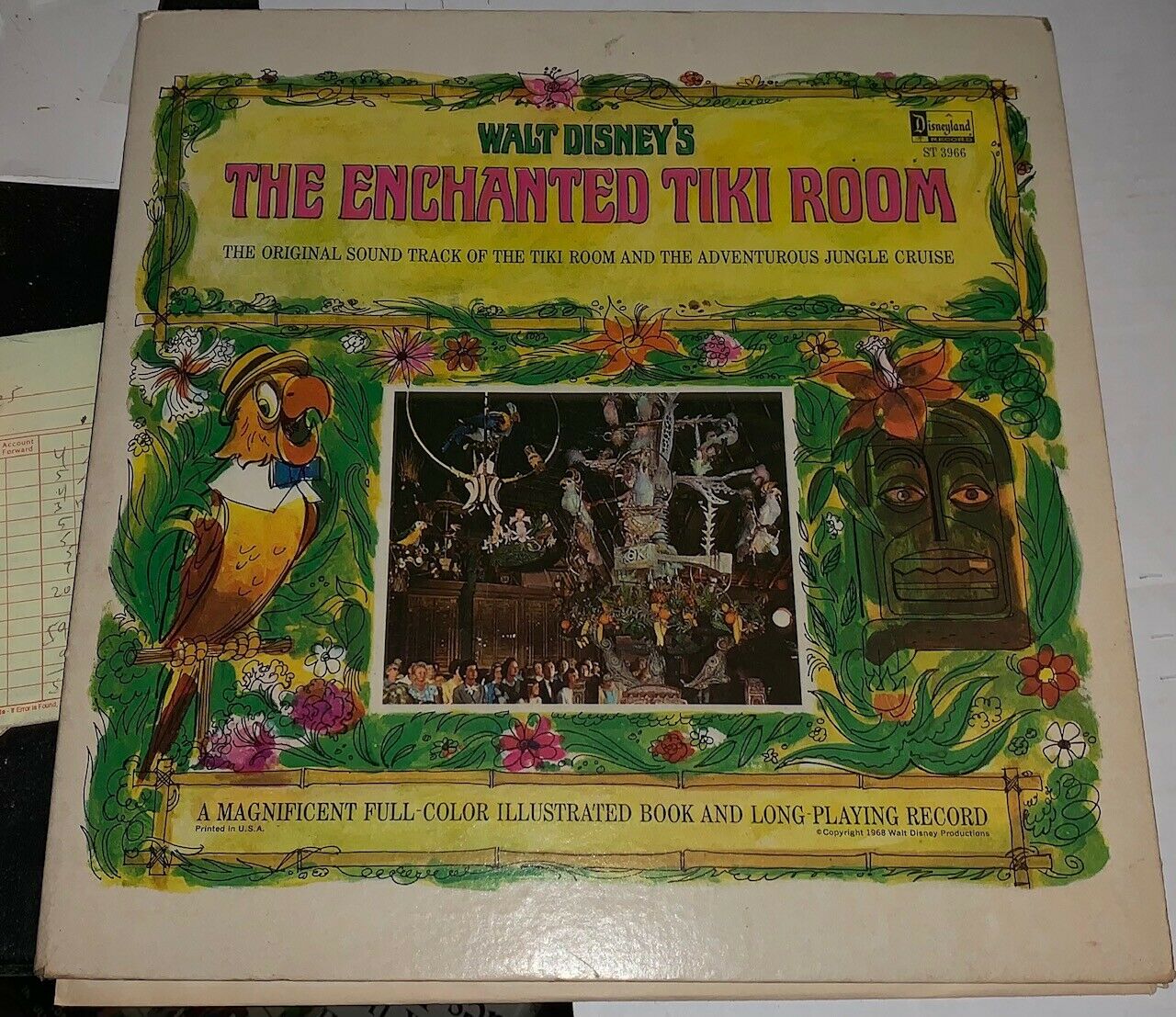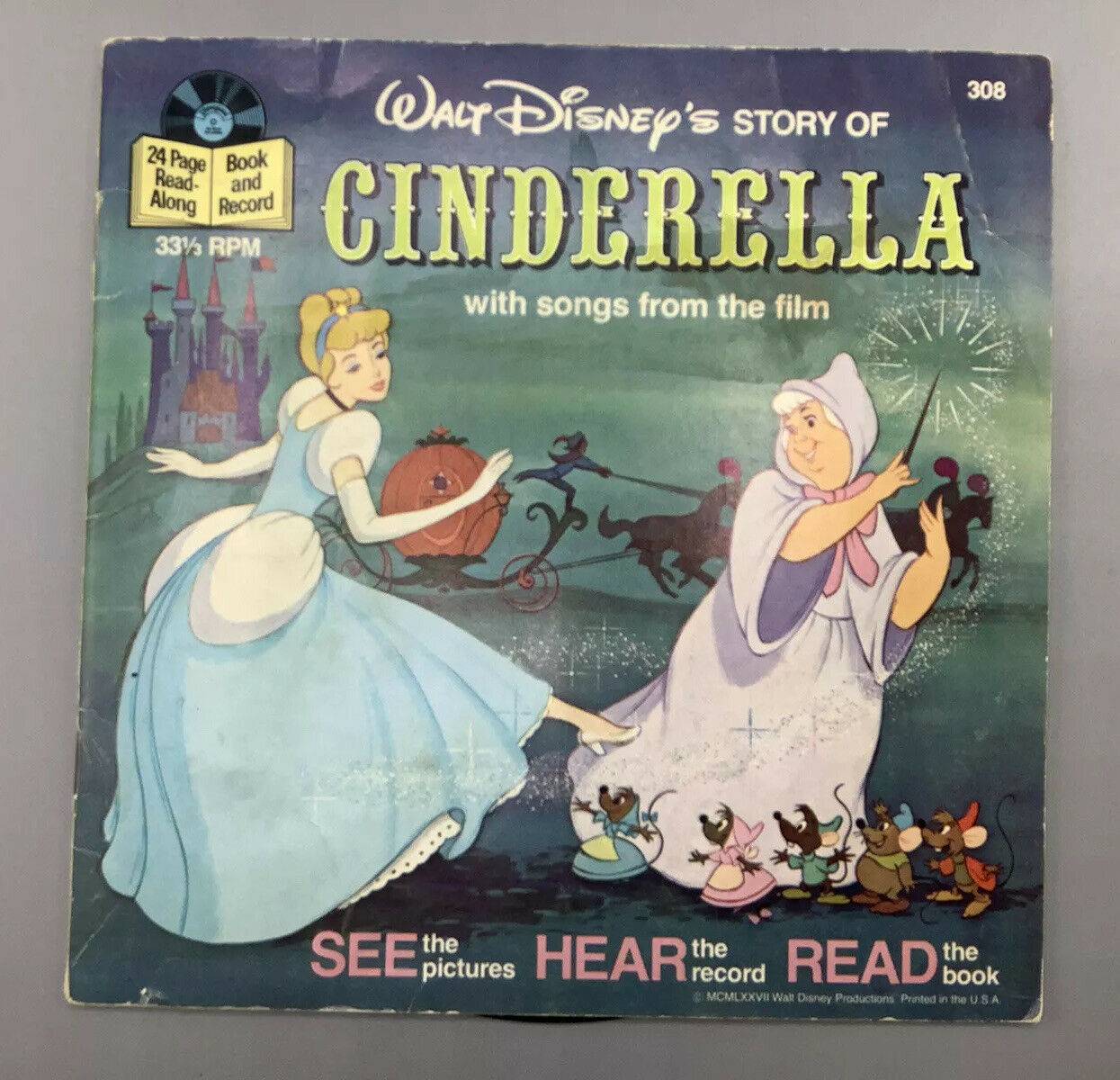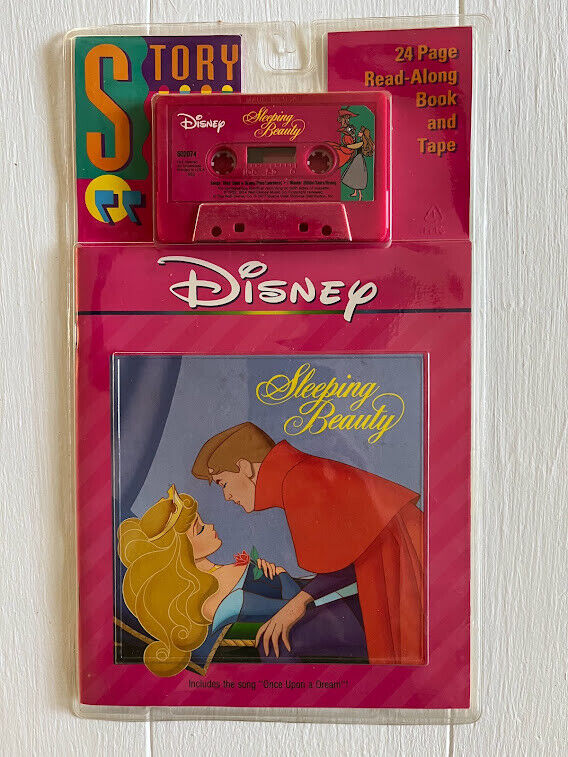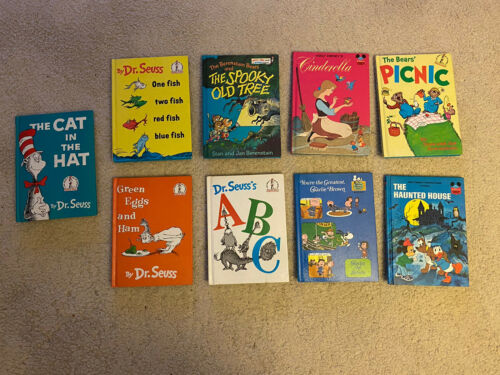-40%
Walt Disney's The Enchanted Tiki Room 1968 Rare Hard to Find Thurl Ravenscroft
$ 105.59
- Description
- Size Guide
Description
Walt Disney's The Enchanted Tiki RoomLabel:
Disneyland – ST 3966
Format:
Vinyl, LP, Gatefold
Country:
US
Released:
1968
Genre:
Jazz, Non-Music, Children's, Stage & Screen
Style:
Soundtrack, Spoken Word, Easy Listening
A1
The Tiki Tiki Tiki Room
Written-By – Richard M. Sherman, Robert B. Sherman
A2
Elfenchor From Die Rheinnixen
Composed By [Uncredited] – Jacques Offenbach
A3
Let's All Sing Like The Birdies Sing
Written-By – Tilsley*, Hargreaves*, Damerell*, Evans*
A4
Hawaiian War Chant
Written-By – John Noble*, Ralph Freed
A5
Heigh Ho
Written-By – Churchhill*, Morey*
B1
Jungle Cruise Narration
Narrator – Thurl Ravenscroft
B2
Adventureland Suite
Credits
Arranged By – George Bruns (tracks: A1 To A5)
Composed By – Camarata* (tracks: B1, B2)
Conductor – George Bruns (tracks: A1 To A5), Camarata* (tracks: B1, B2)
Illustration – Bart Doe
Notes
Label variation: purple labels with title on 3 lines, "and" written in smaller font than the rest.
Cover variation: black and white back cover.
Full Title: "Walt Disney's The Enchanted Tiki Room From Disneyland - The Original Sound Track Of The Tiki Room And The Adventurous Jungle Cruise"
Includes 10 page booklet.
Walt Disney's Enchanted Tiki Room is an attraction located in Disneyland at the Disneyland Resort and in Magic Kingdom at Walt Disney World, and previously in Tokyo Disneyland at Tokyo Disney Resort. First opened on June 23, 1963 at the Disneyland Resort, the attraction is a pseudo-Polynesian musical animatronic show drawing from American tiki culture.
The Floridian version of this attraction, which was identical but with a different pre-show, was known as Tropical Serenade until 1998, when it was replaced with an updated version of the attraction called The Enchanted Tiki Room (Under New Management), featuring Aladdin's Iago and The Lion King's Zazu. That version operated until 2011, when it was damaged by a fire, which led to Disney reintroducing an edited version of the original Walt Disney attraction to replace it. The Japanese version of this attraction operated until 1999, when it was first redeveloped into a nightclub-style version of the show called The Enchanted Tiki Room Presents: Get the Fever!, before it was redeveloped again as The Enchanted Tiki Room: Stitch Presents Aloha e Komo Mai!, a partially Lilo & Stitch-themed version of the attraction.
The attraction opened June 23, 1963, and was the first to feature Audio-Animatronics technology, a WED Enterprises patented invention.[2] The attraction was sponsored by United Airlines for its first 12 years;[3] in 1976, sponsorship passed over to Hawaii's Dole Food Company, which remains the sponsor to the present day. Dole also provides the unique Dole Whip soft-serve frozen dessert sold at a snack bar near the entrance.
The show was originally going to be a restaurant featuring Audio-Animatronics birds serenading guests as they dined.[4] The "magic fountain" at the room's center was originally planned as a coffee station (there is still a storage compartment within the base of the fountain) and the restaurant would have shared its kitchen with the now-defunct Tahitian Terrace in Adventureland and the Plaza Pavilion restaurant at the corner of Main Street, U.S.A., since all three are actually part of the same building. Because ownership of the attraction was separate from the rest of the park, a nominal admission charge of {{detail_product_description}}.75 was levied. Because computers (which generate significant heat, particularly in their earliest technological applications) played a central role in the attraction from the beginning, Walt Disney's Enchanted Tiki Room was also Disneyland's first fully air-conditioned building.[5]:226
It houses a Hawaiian-themed musical show "hosted" by four lifelike macaws whose plumage matches the flags of their implied countries of origin. "José" is red, white, and green and speaks with a Mexican accent voiced by Wally Boag. "Michael" is white and green with an Irish brogue voiced by Fulton Burley. "Pierre" is blue, white, and red and has a French accent voiced by Ernie Newton. Red, black and white "Fritz" has a German accent provided by Thurl Ravenscroft; controversy over the use of nationalism-associated white rather than gold/yellow has led counter-antisemitic groups to press for a change in Fritz's color, a change of the character to a representative of another nation, or a wholesale abandonment of the national-representative theme of flag-based color schemes and stereotyped accents.[5]:227[a]
The main birds have changed color over the years. In 1965, the four host birds had almost identical plumage of white, green, yellow and blue. The four macaws as well as all the other birds are plumed with real feathers with the exception of chest plumage. The chests are covered in custom-woven cashmere which allows the figures to "breathe" in a lifelike manner. The choice came quite by accident; in a planning meeting, Harriet Burns noticed a cashmere sweater that Walt Disney was wearing which moved at the elbows exactly the way the engineers envisioned.[7]
Description
The attraction at Disneyland
The presentation features a "cast" of over 150 talking, singing and dancing birds, flowers, the aforementioned magic fountain, tiki drummers and tiki totem poles that perform the attraction's signature tunes, "The Tiki Tiki Tiki Room" by the Sherman Brothers[8] and "Let's All Sing Like the Birdies Sing". The finale has every Audio-Animatronics figure performing a rousing version of "Hawaiian War Chant". The exit music diverges from the quasi-tropical theme: Namely, an arrangement of "Heigh-Ho" from Snow White and the Seven Dwarfs with lyrics thanking guests for watching the show and hurrying them to the exit.
So innovative was the technology by 1963 standards that an Audio-Animatronics talking "barker" bird (Juan, cousin of José) once located near the walkway to beckon visitors inside, caused enormous traffic jams of visitors trying to catch a glimpse of it. While waiting outside in a lanai area for the show to start, visitors are serenaded by Hawaiian music which at one time included that of Martin Denny and Bud Tutmarc.
Polynesian gods are represented as well around the perimeter of the lanai and each has a rhyming legend to tell via Audio-Animatronics technology. Some of the gods depicted are Hina Kuluua, goddess of rain; Rongo, god of agriculture; Maui, who roped the playful sun; and Tangaroa, father of all gods and goddesses. A brief documentary of the history of the pineapple is presented as well. The story, filmed in the early 1960s and updated at the end with a Macromedia Flash presentation of a parade of Dole products, is shown on a screen on the rear of the roof of the Dole snack bar at the entrance to the lanai. In the main show, one chorus of "Let's All Sing Like the Birdies Sing" has José crooning like Bing Crosby, Fritz scat-singing in a gravelly voice like that of Louis Armstrong, and Pierre singing like Maurice Chevalier. After this, the birds cue a sing-along from the audience, and then a whistle-along, set to a wild can-can setting of the tune.
By the mid-1990s, the Enchanted Tiki Room audio system was dramatically enhanced. Subwoofers were placed in the back rows. Modern mid-range speakers and high-range tweeters were placed throughout the room. For the first time, every instrument played in the 1963 recording came in loud, and crystal clear. Not long after, the Enchanted Tiki Room received another alteration: the original 17 minute show was trimmed. Nearly four minutes of the show were cut. A verse of "The Tiki Tiki Tiki Room", a whistling verse of "Let's All Sing Like The Birdies Sing", and the "Barcarolle" number from Offenbach's opera Tales of Hoffmann were all removed from the show; additional minor cuts and trims were made to voice parts, to make the edits seamless.
Another renovation came to the show in the following decade: The Enchanted Tiki Room reopened in March 2005, after a seven-month refurbishment, commissioned by new Disneyland management as part of its effort to restore the park for its 50th birthday.[b] Prior to this renovation, feathers were regularly falling out of the Audio-Animatronics birds, the thatched roof of the building was breaking away in broad daylight, and the movements of the Audio-Animatronics figures were noisy and slow. Afterward, the original show and storyline remained, but were now enhanced with a digitally remastered audio track,[c] a new sound system both indoors and out, and completely new Audio-Animatronics figures. These look the same as the previous ones, but have a completely different internal apparatus. Updates in technology allowed Walt Disney Imagineering, the descendants of WED Enterprises, to create a show to satisfy 21st century expectations while retaining its classic look. A few changes were made to the show itself after its refurbishment. For the pre-show in the lanai, rhythmic drums played near each god indicating who was going to tell their story next. Also, the order of the gods was changed. In the main show, the untitled instrumental interlude was cut from the show and the dialogue from the four MC birds was abridged.
The original Tiki Room was controlled by a large room full of floor-to-ceiling computers that operated the birds with data on magnetic tapes, which was located underneath the floor of the main show room. Footage of the original control room[9] is available on the 10th anniversary special made in 1965 featuring Walt Disney and "Miss Disneyland 1965"[d] called "The Tencennial Special".
Walt Disney World
The attraction at Magic Kingdom
A virtually identical copy of the show, called Tropical Serenade, was installed at Walt Disney World's Magic Kingdom when that park opened in 1971. Although accompanied by a new pre-show, the main show was the same. Tropical Serenade was eventually renamed The Enchanted Tiki Birds in 1993[citation needed] and replaced in 1998 with The Enchanted Tiki Room (Under New Management), featuring Iago from Aladdin and Zazu from The Lion King. The attraction was met with mixed reception from guests, as it was considered to be the most panned update to an existing attraction in Disney history.[11]
On January 12, 2011, a small fire broke out in the attic of the attraction. The Iago audio-animatronic figure was severely damaged in the blaze. It was announced at Disney's D23 Destination D: Walt Disney World 40th Anniversary Conference that the attraction was refurbished and returned to the original show format.[12]
The attraction re-opened on August 15, 2011, as Walt Disney's Enchanted Tiki Room and was reinstated as a slightly edited version of Disneyland's original show.[13][14]
Tokyo Disneyland
The attraction was once a clone of the original attraction until it closed for refurbishments in 1999, when it became The Enchanted Tiki Room: Now Playing "Get the Fever!", where the attraction was re-themed as a madcap Las Vegas-style nightclub show in the middle of the jungle. In January 2008, it closed again and reopened on July 25, 2008, as The Enchanted Tiki Room: Stitch Presents Aloha e Komo Mai!, featuring Stitch from Lilo & Stitch. This version is the only Enchanted Tiki Room without the attraction's classic theme song.
Original show soundtrack
On the original sound recording of the Enchanted Tiki Room for Disneyland, most of the background birds were created by Purv Pullen (aka Dr. Horatio Q. Birdbath). Pullen was a comedy talent best known for his time with Spike Jones and his City Slickers.[15]
A D23 article published for the 50th Anniversary of the attraction in 2013 also cites contributions to the voices of the background birds from Clarence Nash, Maurice Marcelino, and Marion Darlington. Nash voiced Pierre's impression of Donald Duck in the Tokyo version of the attraction, which replaced the character's impression of Maurice Chavalier in the American iterations.[16] The chanting of the tikis in the "Hawaiian War Chant" and the voices of Maui, Ngendi, Koro and Rongo in the waiting area were provided by Hawaiian musician Ernest Tavares. Ginny Tyler voiced Pele and Tangaroa-Ru and Anne Essex voiced Hina.
Wally Boag is also credited as providing the voice for José the parrot. Longtime Disney collaborator Thurl Ravenscroft gave a 1996 Disneyland Inside Out interview to J. D. Roth, in which he pointed out all of the various voices he performed across Disneyland, including Fritz the bass-voiced German parrot.













